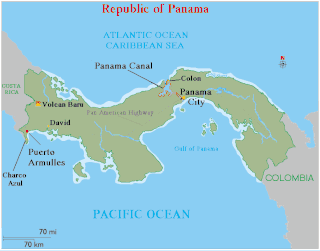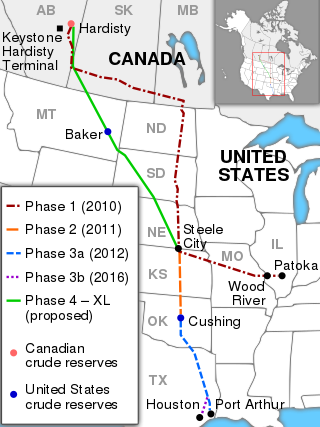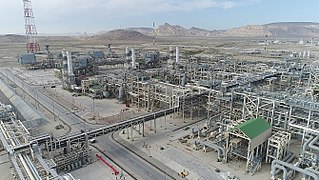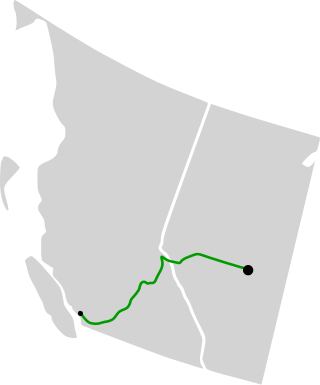Related Research Articles

The Trans-Alaska Pipeline System (TAPS) is an oil transportation system spanning Alaska, including the trans-Alaska crude-oil pipeline, 12 pump stations, several hundred miles of feeder pipelines, and the Valdez Marine Terminal. TAPS is one of the world's largest pipeline systems. The core pipeline itself, which is commonly called the Alaska pipeline, trans-Alaska pipeline, or Alyeska pipeline,, is an 800-mile (1,287 km) long, 48-inch (1.22 m) diameter pipeline that conveys oil from Prudhoe Bay, on Alaska's North Slope, south to Valdez, on the shores of Prince William Sound in southcentral Alaska. The crude oil pipeline is privately owned by the Alyeska Pipeline Service Company.

The Athabasca oil sands, also known as the Athabasca tar sands, are large deposits of bitumen, a heavy and viscous form of petroleum, located in northeastern Alberta, Canada. These reserves are one of the largest sources of unconventional oil in the world, making Canada a significant player in the global energy market.

The Trans-Israel pipeline, also Tipline, Eilat–Ashkelon Pipeline, or Europe–Asia Pipeline is an oil pipeline in Israel extending from the Gulf of Aqaba on the Red Sea to the Mediterranean Sea. It was originally built to transport crude oil originating from Iran inside Israel and to Europe.
The Odesa–Brody pipeline is a crude oil pipeline between the Ukrainian cities Odesa at the Black Sea, and Brody near the Ukrainian-Polish border. There are plans to expand the pipeline to Płock, and furthermore to Gdańsk in Poland. The pipeline is operated by UkrTransNafta, Ukraine's state-owned oil pipeline company.
The Enbridge Pipeline System is an oil pipeline system which transports crude oil and dilbit from Canada to the United States. The system exceeds 5,000 kilometres (3,100 mi) in length including multiple paths. More than 3,000 kilometres (1,900 mi) of the system is in the United States while the rest is in Canada and serves the Athabasca oil sands production facilities. Main parts of the system are 2,306-kilometre-long (1,433 mi) Canadian Mainline and 3,057-kilometre-long (1,900 mi) Lakehead System. On average, it delivers 1.4 million barrels per day of crude oil and other products to the major oil refineries in the American Midwest and the Canadian province of Ontario. The Canadian portion is owned by Enbridge, while the U.S. portion is partly owned by that company through Enbridge Energy Partners, LP, formerly known as Lakehead Pipe Line Partners and Lakehead Pipe Line Company.
Petroleum production in Canada is a major industry which is important to the overall economy of North America. Canada has the third largest oil reserves in the world and is the world's fourth largest oil producer and fourth largest oil exporter. In 2019 it produced an average of 750,000 cubic metres per day (4.7 Mbbl/d) of crude oil and equivalent. Of that amount, 64% was upgraded from unconventional oil sands, and the remainder light crude oil, heavy crude oil and natural-gas condensate. Most of the Canadian petroleum production is exported, approximately 600,000 cubic metres per day (3.8 Mbbl/d) in 2019, with 98% of the exports going to the United States. Canada is by far the largest single source of oil imports to the United States, providing 43% of US crude oil imports in 2015.

Puerto Armuelles is a city and corregimiento on Panama's Pacific coast in western Chiriquí Province adjacent to Costa Rica. It is the seat of the Barú District and the second-largest city in Chiriqui province with a population of nearly 25,000. Puerto Armuelles has two types of deep-water ports: one for bananas and another for oil.
The Cherry Point Refinery is an oil refinery near Bellingham, Washington, north of Seattle in the United States. Owned by BP, is the largest refinery in Washington state. It is located about seven miles (11 km) south of Blaine and eight miles (13 km) northwest of Ferndale, a few miles south of the Canada–US border, on the Strait of Georgia between Birch Bay and Lummi Bay.

Charco Azul is a bay and port just outside Puerto Armuelles, in the southwest corner of Panama near the border with Costa Rica. It lies just to the east of the Burica Peninsula, and forms part of the larger Gulf of Chiriquí.

The Keystone Pipeline System is an oil pipeline system in Canada and the United States, commissioned in 2010 and owned by TC Energy and, as of March 2020, the Government of Alberta. It runs from the Western Canadian Sedimentary Basin in Alberta to refineries in Illinois and Texas, and also to oil tank farms and an oil pipeline distribution center in Cushing, Oklahoma.

The Sangachal Terminal is an industrial complex consisting of a natural gas processing plant and oil production plant, located on the coast of the Caspian Sea 45 kilometres (28 mi) south of Baku, Azerbaijan.

The Irving Oil Refinery is a Canadian oil refinery located in Saint John, New Brunswick. It is currently the largest oil refinery in Canada, capable of producing more than 320,000 barrels (51,000 m3) of refined products per day. Over 80 per cent of the production is exported to the United States, accounting for 19 per cent of the country's gasoline imports and 75 per cent of Canada's gasoline exports to the US.
The Seaway Crude Pipeline System (SCPS), commonly known as the Seaway Pipeline, is an oil pipeline system which transports crude oil between Cushing, Oklahoma and Freeport, Texas, and through the Texas City, Texas Terminal and Distribution System on the Gulf Coast of the United States. The Seaway is an important crude oil transfer link between two petroleum regions within the United States.
Western Canadian Select (WCS) is a heavy sour blend of crude oil that is one of North America's largest heavy crude oil streams and, historically, its cheapest. It was established in December 2004 as a new heavy oil stream by EnCana (now Cenovus), Canadian Natural Resources, Petro-Canada (now Suncor) and Talisman Energy (now Repsol Oil & Gas Canada). It is composed mostly of bitumen blended with sweet synthetic and condensate diluents and 21 existing streams of both conventional and unconventional Alberta heavy crude oils at the large Husky Midstream General Partnership terminal in Hardisty, Alberta. Western Canadian Select—the benchmark for heavy, acidic (TAN <1.1) crudes—is one of many petroleum products from the Western Canadian Sedimentary Basin oil sands. Calgary-based Husky Energy, now a subsidiary of Cenovus, had joined the initial four founders in 2015.

The Trans Mountain Pipeline System, or simply the Trans Mountain Pipeline(TMPL), is a multiple product pipeline system that carries crude and refined products from Edmonton, Alberta, to the coast of British Columbia, Canada.

The East African Crude Oil Pipeline (EACOP), also known as the Uganda–Tanzania Crude Oil Pipeline (UTCOP), is a 1,443 km crude oil pipeline in planning since 2013, with a foundation stone nominally under construction since 2017 and intended to transport crude oil from Uganda's Tilenga and Kingfisher oil fields to the Port of Tanga, Tanzania on the Indian Ocean.

Chiriquí Lagoon is a large lagoon on the northwest coast of Panama covering an area of about 900 square kilometres (350 sq mi). It is separated from the Caribbean Sea by the Valiente Peninsula to the east and from Almirante Bay by islands in the Bocas del Toro Archipelago to the northwest, including Cayo Agua and Isla Popa. The widest and deepest entrance into the bay is the Canal del Tigre in the northeast, which is the main access channel for ships entering the lagoon.

The 2018 Balikpapan oil spill was an oil spill off the coast from the city of Balikpapan, Indonesia. It was caused by a cracked pipeline linked to a Pertamina refinery in the city.
The city of Cushing in Oklahoma is a central hub within the United States and worldwide oil industry. It connects major pipelines within the United States and is the location where the oil futures contracts end up being delivered.
References
- 1 2 3 "BP Finds Shortcut To US West Coast Refineries". Downstream Today. 2008-05-28. Retrieved 2008-05-31.
- 1 2 3 4 5 Suman, Daniel (1987). "Socioenvironmental impacts of Panama's trans-isthmian pipeline". Environ. Impact Assess. Rev. 7: 227–246.
- 1 2 Fellers, Gordon (1 June 2004). "Where are the world's oil transit chokepoints?". Pipeline & Gas Journal. Retrieved 2008-05-31.
- 1 2 "Central America Energy Data, Statistics and Analysis - Oil". Energy Information Administration. November 2007. Retrieved 2008-05-31.
- ↑ Smith, Christopher E. (2009-08-28). "Tesoro starts oil flow through reversed Panama pipeline". Oil & Gas Journal . PennWell Corporation . Retrieved 2009-09-05.
- ↑ Watkins, Eric (2009-10-15). "Contract let for Panamanian terminal expansion". Oil & Gas Journal . PennWell Corporation . Retrieved 2009-10-17.
- ↑ "Republica de Panama acquires Petroterminal de Panama SA (pending)". Thomson Financial Mergers & Acquisitions. 2008-04-22. Retrieved 2008-05-31.